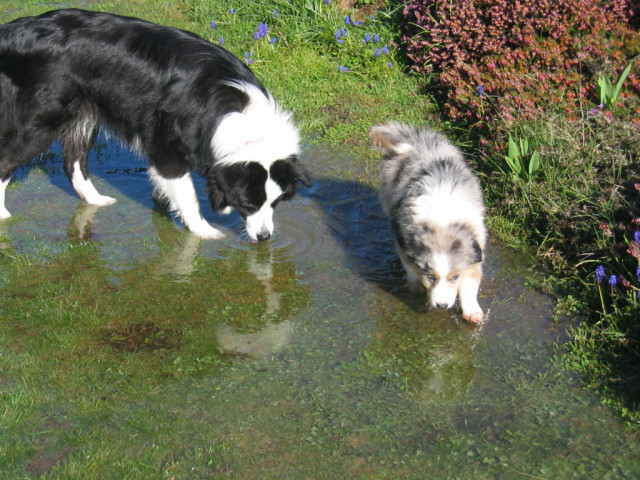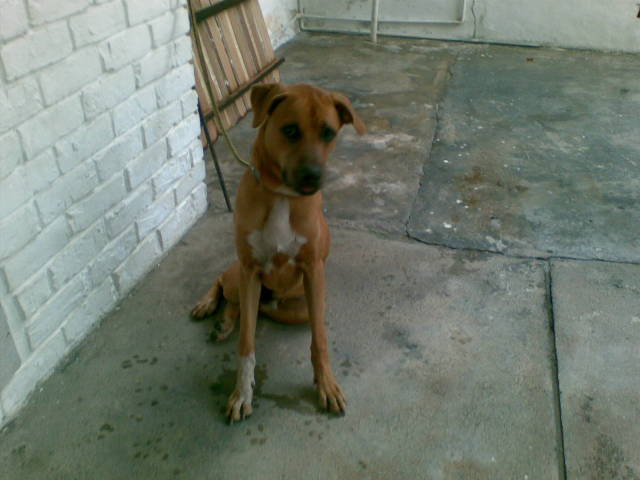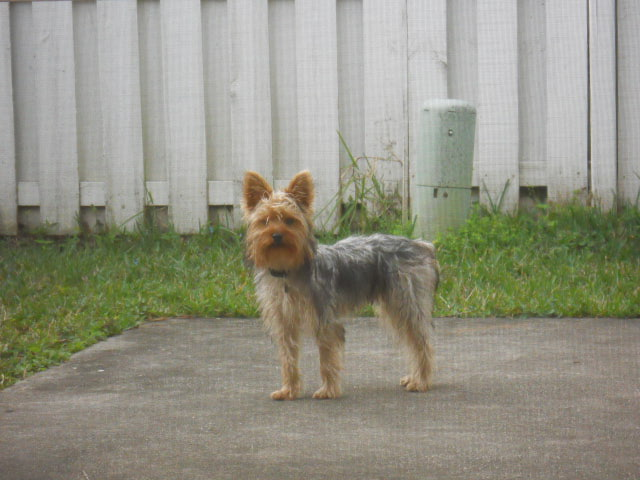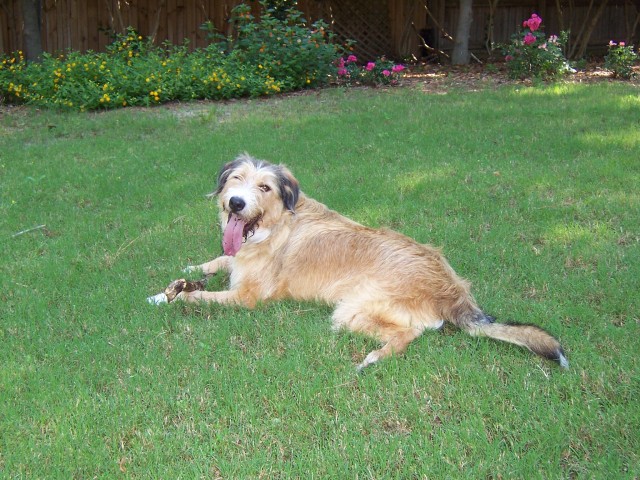QuestionWe adopted an 8 mon-old female Borador (Border Collie X Lab) at the end of
March who is the sweetest
dog, but she received absolutely no training (or grooming). She accomplished
house training in three
days, trained to bring in our newspaper (no one else's) in 30 seconds, trained to
heel in one session, has
essentially stopped chasing squirrels while on lead, has slowly limited her cat
chasing (our cat in the
house), will sit or down and stay for her food until she gets the ok, but, she's
quite headstrong and it's
hard to get her full attention for general behavioral training. Everything we do
with her is a training
lesson, but we can't get her to always come when called or to respond to
commands when she's excited
about something/anything. For her safety, I want her to come, to stop what
she's doing, sit and stay (or
down) anywhere even where there are distractions but getting her attention is
the hard part. She smart
enough to learn anything, but apparently I'm not smart enough to teach her
somethings. She's too smart
for my own good. We've had trainers come to the house and while there have
been successes, on our
own, there are failures. What to do?
AnswerI've met (and read!) people whose dogs are smarter than they are, you're NOT one of them lol: you've accomplished an awful lot in a very short time! Your "problem" is twofold: the age of the dog (8 months is young, excitable, emotionally scattered, brain is still changing, lots of energy, the "terrible twos" of dogdom!) and breed mix (Border Collies are driven and single minded).
First, let's examine your goals: asking a dog to come when called regardless of the dog's emotional state/thought patterns is a very high expectation and requires a great deal (months) of consistent, rewarding training. The recall is the single most difficult behavior to capture because most people go at it in the wrong way. For instance: dog is doing something objectionable, owner calls dog, dog happily redirects and goes to owner, owner yells at dog or puts dog in crate; OR dog is happily at play in dog park, owner calls dog, dog happily redirects to owner, owner attaches leash and LEAVES dog park. What happens NEXT, after the dog has responded to the recall, determines what happens EVERY TIME thereafter. ONE unhappy experience can kill a recall.
SO: if your dog won't "come" on command, stop using that word. Start over. With your new word, you must associate high value reward with the dog seated in front of you. Any dog can be trained to respond to a whistle or special word (the "cue", I use "presto") by seating the dog in front of you (step toward the dog holding treat over the dog's head, it will sit), "cue" the dog and pop high value reward into dog's mouth; back up, dog should follow, wait for dog to sit or step toward him again as above, use cue , pop treat in mouth; go a few feet away, if dog gets up to follow scoot down and use "cue", dog should come right to you -- wait for him to figure out he needs to "sit", pop jackpot (bunch of treats) in his mouth, end event. Repeat randomly over the course of a few days until you've reached 30 to 50 repetitions. The dog should now have a conditioned response: when he hears the cue, he will come to sit in front of you for high value treat.
You can begin to play "hide and seek" in the house and "round robin recall" with family members outdoors: seated in a large circle, people randomly (not in order) call dog's name with the cue: when dog gets to that person he receives a high value treat. A few minutes two to three times a week for a couple of weeks establishes this recall outdoors (where it is very difficult to get a dog's attention). Then you are ready to use very long training leash in other outdoor areas to further develop your recall. But remember: NEVER use the recall for any negative purpose. ALWAYS reward the dog when he comes to you (if you don't have treats handy, praise will do but you can't totally eliminate the treats for quite a while). WORK the recall on a daily basis so the dog will become accustomed to it. Do NOT expect the dog to recall to you if he is frightened or in prey drive mode UNLESS he is 100% compliant at all other times. Do NOT test the recall by allowing the dog off leash in public areas. Some dogs can never be trusted for a solid recall, this breed mix should, but it will take time.
As for "drop" (sit or down) on command in mid-stride, yes this can be done but, again, it's a sophisticated adjunct to the usual obedience routine and takes time to develop. One starts by teaching "sit", "drop" (or "down"), "stand" in controlled circumstances until the dog is 100% reliable (can take days or weeks), then randomly ask for one of these behaviors at a time when the dog is not highly distracted and slowly raise our threshold of behavior (meaning: no reward for common reaction, larger reward for compliance in more difficult circumstances although we still RANDOMLY reward easy compliance). "Stay" on cue is also trained the same way. You can watch Dr. Ian Dunbar demonstrate how to teach "stand" and "sit/stay" in the following links:
http://www.youtube.com/watch?v=wcPnuCeHxfA&feature=more_related
http://www.youtube.com/watch?v=dSyId-SGRMc&NR=1
Dr. Dunbar uses positive reinforcement without a marker signal (clicker). Karen Pryor uses the marker signal. This is a cue to the dog that reward is coming which prevents the dog from working for 'bribes'. Some dogs will not work if food is not involved and this is ALWAYS THE FAULT OF THE TRAINING, meaning the trainer! The marker signal eliminates this "problem". To learn about this method you can read her book, "Getting Started: Clicker Training for Dogs" and visit her site, ClickerTraining.com.

 Dog in Heat?
QuestionLily and Jorge
QUESTION: Hello,
We have
Dog in Heat?
QuestionLily and Jorge
QUESTION: Hello,
We have
 dogs behaviour
QuestionMy 8 months old Dusto
QUESTION: My puppy
dogs behaviour
QuestionMy 8 months old Dusto
QUESTION: My puppy
 agressive silky terrier
Question
Lucas 1 year old
Hi Jennifer:
I have a
agressive silky terrier
Question
Lucas 1 year old
Hi Jennifer:
I have a
 Post bladder surgery potty training for INDOORS!
QuestionTiki
QUESTION: Dear Dr. Connor,
My 10 ye
Post bladder surgery potty training for INDOORS!
QuestionTiki
QUESTION: Dear Dr. Connor,
My 10 ye
 anxious dog
Question
Louie
Hi, We adopted a 2 year old male A
anxious dog
Question
Louie
Hi, We adopted a 2 year old male A